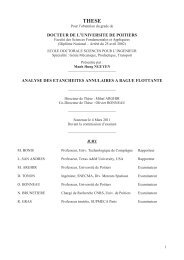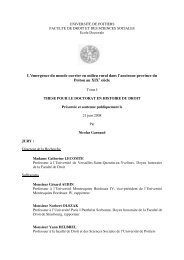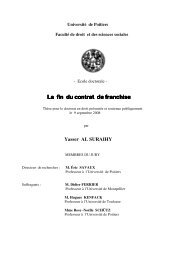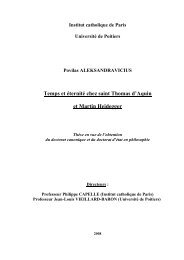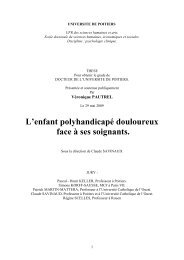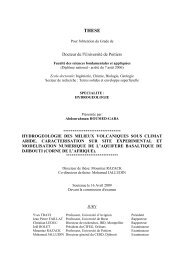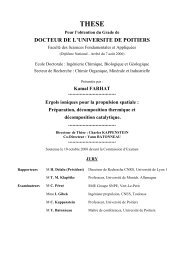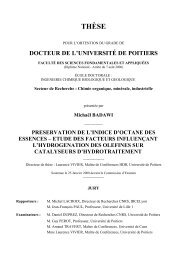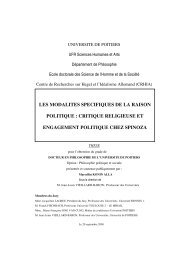Etude et développement d'un actionneur plasma à décharge à ...
Etude et développement d'un actionneur plasma à décharge à ...
Etude et développement d'un actionneur plasma à décharge à ...
Create successful ePaper yourself
Turn your PDF publications into a flip-book with our unique Google optimized e-Paper software.
Annexes<br />
- 186 -<br />
Figure 7 Temporal evolution of the vy velocity component along different slices at (1) y/C=0.13, (2)<br />
y/C=0.075, (3) y/C=-0.015 and (4) y/C=-0.125<br />
The estimation of the frequency of the vortex shedding is not easy if it is based on the temporal evolution<br />
only. To overcome this drawback, the single-point temporal correlation functions based on vy are computed at<br />
R τ over the whole PIV field is performed by a spatial<br />
each point of the PIV grid while the estimation of ( )<br />
22<br />
averaging of the correlation functions:<br />
R<br />
22<br />
( τ )<br />
=<br />
nk<br />
nj<br />
∑∑<br />
k = 1 j = 1<br />
nk<br />
nj<br />
∑∑<br />
k = 1 j = 1<br />
22<br />
22<br />
( k , j , τ )<br />
R x y<br />
( k , j ,0)<br />
R x y<br />
where nk and nj refer to the maximal indices of the PIV grid in the x and y direction, respectively. Finally, a<br />
rep<strong>et</strong>itive flow patterns occurring during the sequence acquisition could be identified and would result in regular<br />
peaks in the spatially averaged correlation function. The figure 8 shows the single-point correlation function<br />
averaged over the whole PIV field. This figure reveals a correlation peak oscillating at approximately 90 Hz. A<br />
manual estimation of the vortex shedding frequency estimated from sequences of located eddy such the one<br />
shown in figure 6 confirms that a rep<strong>et</strong>itive flow pattern is reproduced at a frequency ranging b<strong>et</strong>ween 80 and<br />
100 Hz. One can remark that this shedding frequency corresponds to a reduced frequency, F + , ranging from 0.8<br />
up to 1. This reduced frequency range corresponds pr<strong>et</strong>ty well with the results published in previous studies<br />
reporting that optimal effects in term of lift coefficient are measured when the airflow is forced with nonstationary<br />
actuation operated at a reduced frequency near unity [7, 11, 34]. This may be explained by the fact<br />
that a reduced frequency of one approximately corresponds to the frequency of the natural vortex shedding.<br />
Figure 8 Temporal cross-correlation based on spatially averaged single-point correlations for the baseline<br />
flow<br />
B. Flow Controlled by a Quasi-steady Actuation<br />
As previously mentioned, the quasi-steady actuation consists of applying a sine waveform having an<br />
amplitude of 18 kV at 1.5 kHz. The resulting time-averaged flow field when the actuator is switched on is shown<br />
in figure 9. This confirms the authority of the control strategy. The airflow is now reattached along the suction<br />
side up to 70% of the chord length (Figure 9a) while the turbulent intensity is largely reduced in the free shear<br />
layer region (Figure 9b). However, the leading edge of the airfoil presents high turbulent intensity, probably due



